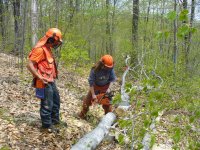4570Man
Super Star Member
- Joined
- Apr 7, 2015
- Messages
- 18,982
- Location
- Crossville, TN
- Tractor
- Kubota M59, Kubota L3800, Grasshopper 428D, Topkick dump truck, 3500 dump truck, 10 ton trailer, more lighter trailers.
My neighbor lent me his almost new MS170 to try out, I was limbing a pine that came down.
WOW, I was really disappointed in the lack of power,, I am just not patient enough to wait for that saw to slowly cut.
The saw had a brand new chain on it,,,
I guess I would just rather pick up a big saw,,, and watch it fly through small stuff,,,
I’ve had tiny saws and that’s a no go for me. I don’t tend to cut any firewood smaller 3-4”. I use my Husky 353 for small work and a brush blade weed eater for cutting brush.

